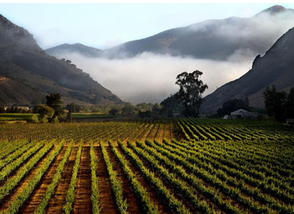 The first cool climate Syrah vineyard in California
The first cool climate Syrah vineyard in California Some wines are special because of where/when you discovered them.
Some are special because of their price.
Some are special because of what they represent.
Qupé (pronounced kyoo-pay') is special to me because it represents my first official Christmas present from my stepson's own earnings. Welcome to adulthood.
Visiting us in London last December, he visited Selfridge's wine department armed with a rudimentary idea about what kind of wines we like, and selected this with the help of one of the staff. It's fair to say that Selfridge's won't always be the cheapest, but in this type of service, they excel.
Dan's choice was a success!

It's one of my favourite varietals and it seems to be a fashionable favourite of many, being the third most planted red wine grape in the world, behind Merlot and Grenache. But in California, where fashion rules, plantings have remained quite static in the last ten years, leaving just a few producers, who aren't obsessed with producing the perfect Pinot (the Sideways effect).
It's also a great grape for blending with anything from it's Rhone stable mates Grenache and Mourvedre, to structure heavy Cabernet Sauvignon and even whites such as voluptuous Viognier, and you'll find single varietals and blends from most major wine producing countries from Serbia to Uruguay.
 2010 13.5% around £22 (Selfridges)
2010 13.5% around £22 (Selfridges) Biodynamic farming also focuses on the lunar calendar and uses unusual techniques such as horn manure spraying on root stocks. While it might seem like so much hocus pocus to the uninitiated, biodynamic principles are being used in more and more vineyards. Many people claim they can taste the difference.
There's also been a marked interest in using the biodynamic calendar to show wines at their best for trade tastings, press launches etc. If you want to read more about why people believe wine tastes better from one day to the next, check out this link, and you can find out if today is a good day for opening your best bottle using this link. I've not done enough research to make up my own mind about this, let alone inform your opinions, but I'd love to hear from anyone who has.

Simple answer, yes.
But of course, at around £20 a bottle, one would expect it to be rather more than just "good". The northern Rhone is the spiritual home of Syrah, and also it's likely birthplace. And, in Europe at least, we can buy many great Rhone examples for a similar price tag. So what makes this wine worth trying?
Mr Purple Teeth loved it's rich, smoothness, medium body and smoky, dark fruit flavours. And while he called it "a big wine", this is by no means one of those enormous Shiraz type wines. It's balanced alcohol is just 13.5%, positively restrained for a new world Syrah varietal, and the tannins are subtle.
I loved the violet, blackberry and blueberry on the nose. There was an almost perfumed scent which wasn't just dominated by the fruit. On the palate, I found perhaps nutmeg rather than peppery spice, and an elegant restraint. Well-balanced with a long finish of warming toasted vanilla notes, the silky tannins were almost imperceptible until you look for them. It's very rounded, juicy and soft, making it an appealing choice on the occasion we drunk it, to celebrate my latest consulting gig.
It's not a classic Californian wine, but neither is it a Rhone replica. Bridging the two styles with fruit and elegance, it's a serious bottle that is more likely to appeal to fans of the subtle, if you can apply the word subtle to such an intense flavour.
Will I buy it again? At the moment, my wine rack is extending across all possible work-surfaces, to the extent that some wines for an event I'm organising are currently being stored in a wardrobe, so, not right now. It does pop up on restaurant wine-lists from time to time though, and I think this would work well with food, perhaps a venison loin, a lamb shoulder or a sweet and smoky barbecued chicken. Let me know if you try it. I'd love to hear what you think.
Cheers!


 RSS Feed
RSS Feed
